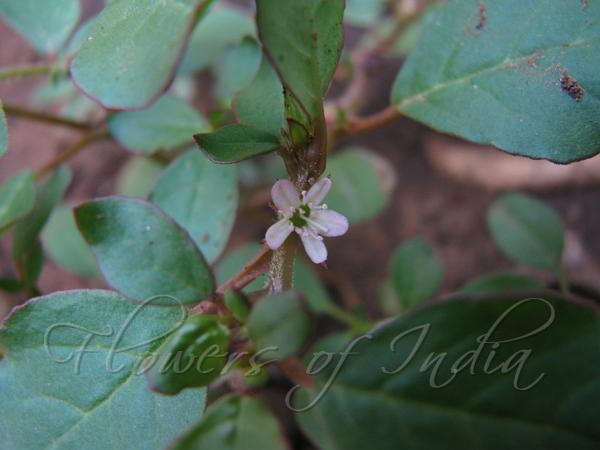|
| Desert Horse Purslane |
|

|

| File size | 89606 |
| Original date | |
| Resolution | 0 x 0 |
| Flash | Flash did not fire, auto |
| Focal length | 6.0mm |
| Exposure time | 1/50s |
| Aperture | 2.7 |
| Focus Distance | |
| Metering Mode | Multi-segment |
| Camera make | Canon |
| Camera model | Canon PowerShot S5 IS |
| Sensor type | OneChipColorArea |
|
|
|
|
Photo: |
Botanical name: Trianthema portulacastrum Family: Aizoaceae (Ice plant family)
Synonyms: Trianthema monogynum, Trianthema procumbens, Portulaca axilliflora
Synonyms: Trianthema monogynum, Trianthema procumbens, Portulaca axilliflora
Desert Horse Purslane is a weed found throughout
the tropical and subtropical countries. It occurs in wastelands,
roadsides, lawns, gardens, cultivated crops, and in paddy fields if the
water supply is low. Stems are prostrate or rising, somewhat succulent, up
to 50 cm long or more, smooth or sparsely velvety. Leaves are flat,
elliptic to obovate or spade-shaped, 1-2 cm long, 0.4-2 cm wide, margins
entire, tip blunt, base rounded to wedge-shaped. Leaf stalks are 0.5-2.5
cm long, expanded into a sheath joined with opposing leaf base to form a cup. Pink flowers are borne solitary, stalkless, largely hidden in leaf
axils. Petals (perianth lobes) are linear to narrowly deltate, 4-5 mm
long, inner surface pink or white, sparsely velvety externally; ovary
cylindrical; style about 2 mm long.
Medicinal uses: The roots are used to relieve obstructions of the liver, and to relieve
asthma and amenorrhoea. A decoction of the powdered root is taken to
treat venereal discharge.
The leaves are used in the treatment of oedema, jaundice, strangury and
dropsy. The old leaves are used in a treatment against gonorrhoea. The
fleshy nature of the leaves makes them suitable for use as a
wound-dressing or poultice.
The roots are used to relieve obstructions of the liver, and to relieve
asthma and amenorrhoea. A decoction of the powdered root is taken to
treat venereal discharge.
The leaves are used in the treatment of oedema, jaundice, strangury and
dropsy. The old leaves are used in a treatment against gonorrhoea. The
fleshy nature of the leaves makes them suitable for use as a
wound-dressing or poultice.
Medicinal uses:
 The roots are used to relieve obstructions of the liver, and to relieve
asthma and amenorrhoea. A decoction of the powdered root is taken to
treat venereal discharge.
The leaves are used in the treatment of oedema, jaundice, strangury and
dropsy. The old leaves are used in a treatment against gonorrhoea. The
fleshy nature of the leaves makes them suitable for use as a
wound-dressing or poultice.
The roots are used to relieve obstructions of the liver, and to relieve
asthma and amenorrhoea. A decoction of the powdered root is taken to
treat venereal discharge.
The leaves are used in the treatment of oedema, jaundice, strangury and
dropsy. The old leaves are used in a treatment against gonorrhoea. The
fleshy nature of the leaves makes them suitable for use as a
wound-dressing or poultice. | Identification credit: Prashant Awale | Photographed in Vadodara, Gujarat & Delhi. |
• Is this flower misidentified? If yes,